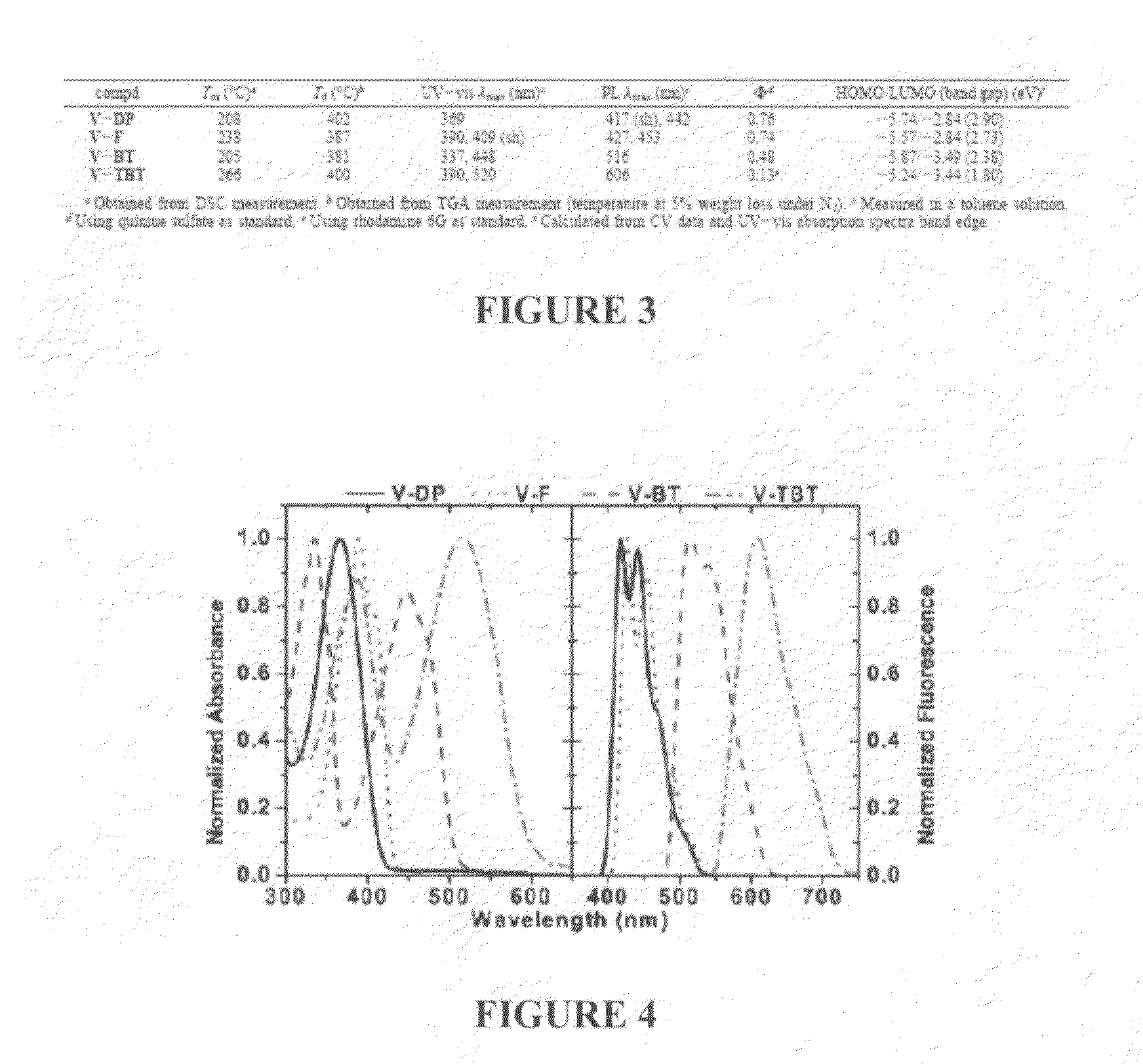N-type conjugated materials based on 2-vinyl-4,5-dicyanoimidazoles and their use in organic photovoltaics
a technology of dicyanoimidazole and conjugated materials, which is applied in the field of organic photovoltaics, can solve the problems of difficult synthesis of materials, high cost of production of these materials, and the possibility of vacuum deposition of these compounds, and achieves high external quantum efficiency, efficient and cost-effective
- Summary
- Abstract
- Description
- Claims
- Application Information
AI Technical Summary
Benefits of technology
Problems solved by technology
Method used
Image
Examples
example 1
[0107]Experimental Section
[0108]General Description: All commercially available materials were used as received unless noted otherwise. Cy2NMe was distilled prior to use. 4,7-bis(5-bromo-2-thienyl)-2,1,3-benzothiadiazole was prepared according to literature procedures (Hou, Q.; Xu, Y.; Yang, W.; Yuan, M.; Peng, J.; Cao, Y. J. Mater. Chem. 2002, 10, 2887). All reactions were carried out using Schlenk techniques in an argon or nitrogen atmosphere with anhydrous solvents.
[0109]Instruments: 1H, and 13C NMR data were performed on a Bruker DPX 400 MHz spectrometer with chemical shifts referenced to CDCl3 or C4D8O. Matrix assisted laser desorption / ionization time-of-flight (MALDI-TOF) mass spectra were obtained on a Bruker Autoflex TOF / TOF instrument using dithranol as a matrix and silver trifluoroacetate as an ionizing salt when necessary. Differential scanning calorimetry (DSC) was carried out under nitrogen on a DSC Q100 instrument (scanning rate of 10° C.min−1). Thermal gravimetric ana...
example 2
[0126]The above-described reactions were carried out using vinazene materials synthesized using the Ar groups indicated in FIG. 11. Compounds 3, 4, 5 and 7 correspond to V-DP, B-BT, B-TBT and V-F, described above.
[0127]Details for the Heck Reactions for compounds 1 to 14 are as follows.
[0128]1. Using 1,4-dibromobenzene (71 mg, 0.30 mmol), 1-hexylvinazene (171 mg, 0.75 mmol), Cy2NMe (0.161 mL, 0.75 mmol), Pd[P(t-Bu)3]2 (3.1 mg, 0.006 mmol), and DMF (2 mL). After workup, the product was obtained as yellow solids (120 mg, 75% yield). 1H NMR (CDCl3): δ 0.90 (t, 6H, J=7.2 Hz), 1.36 (unresolved m, 12H), 1.86 (q, 4H, J=6.8 Hz), 4.19 (t, 4H, J=7.6 Hz), 6.80 (d, 2H, J=16.0 Hz), 7.60 (s, 4H), 7.87 (d, 2H, J=15.6 Hz). 13C NMR (CDCl3): δ 14.0, 22.5, 26.2, 30.8, 31.2, 46.7, 108.6, 111.2, 111.8, 112.5, 123.0, 128.4, 136.6, 139.5, 149.7. Anal. Calcd for C32H34N8: C, 72.43; H, 6.46; N, 21.12. Found: C, 72.27; H, 6.79; N, 21.29. MS (MALDI-TOF) m / z 531.37 (M+); calcd. for C32H34N8=531.29.
[0129]2. Usi...
PUM
| Property | Measurement | Unit |
|---|---|---|
| thick | aaaaa | aaaaa |
| thick | aaaaa | aaaaa |
| thick | aaaaa | aaaaa |
Abstract
Description
Claims
Application Information
 Login to View More
Login to View More - R&D
- Intellectual Property
- Life Sciences
- Materials
- Tech Scout
- Unparalleled Data Quality
- Higher Quality Content
- 60% Fewer Hallucinations
Browse by: Latest US Patents, China's latest patents, Technical Efficacy Thesaurus, Application Domain, Technology Topic, Popular Technical Reports.
© 2025 PatSnap. All rights reserved.Legal|Privacy policy|Modern Slavery Act Transparency Statement|Sitemap|About US| Contact US: help@patsnap.com



